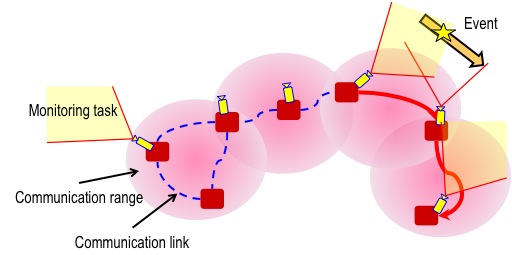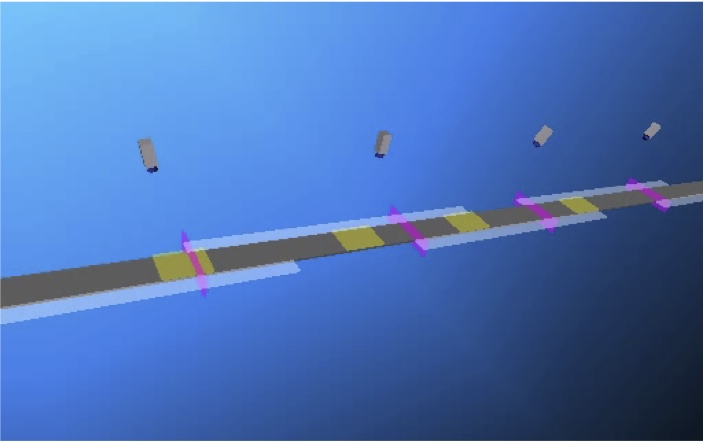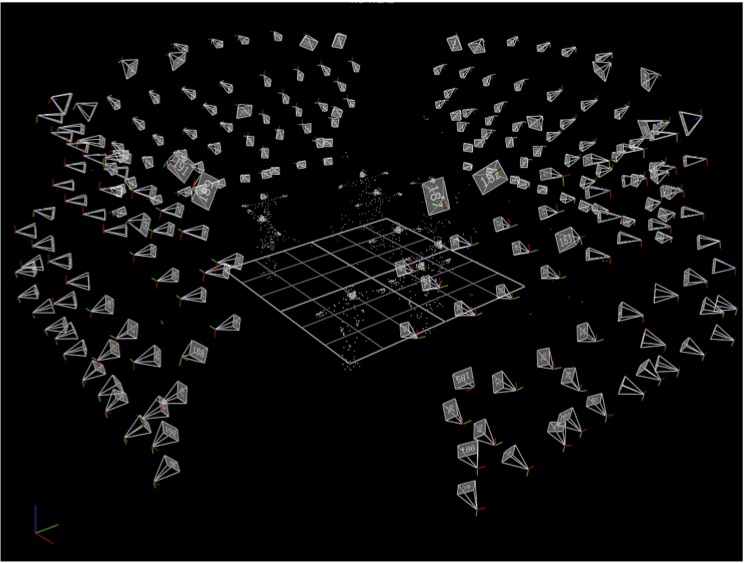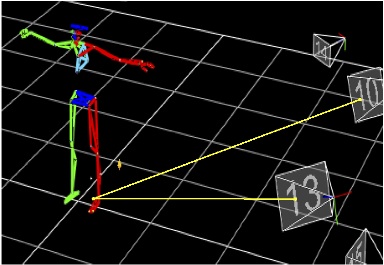2022
L. Varotto, M. Fabris, G. Michieletto, A. Cenedese.
Visual sensor network stimulation model identification via Gaussian mixture model and deep embedded features. Engineering Applications of Artificial Intelligence, vol. 114pp. 105096, 2022
Abstract:
Visual sensor networks (VSNs) constitute a fundamental class of distributed sensing systems, with unique complexity and appealing performance features, which correspondingly bring in quite active lines of research. An important research direction consists in the identification and estimation of the VSN sensing features: these are practically useful when scaling with the number of cameras or with the observed scene complexity. With this context in mind, this paper introduces for the first time the idea of Stimulation Model (SM), as a mathematical relation between the set of detectable events and the corresponding stimulated cameras observing those events. The formulation of the related SM identification problem is proposed, along with a proper network observations model, and a solution approach based on deep embedded features and soft clustering. In detail: first, the Gaussian Mixture Modeling is employed to provide a suitable description for data distribution, while an autoencoder is used to reduce undesired effects due to the so-called curse of dimensionality emerging in case of large scale networks. Then, it is shown that a SM can be learnt by solving Maximum A-Posteriori estimation on the encoded features belonging to a space with lower dimensionality. Numerical results on synthetic scenarios are reported to validate the devised estimation algorithm.
[
url] [
BibTeX]
J. Giordano, M. Lazzaretto, G. Michieletto, A. Cenedese.
Visual Sensor Networks for Indoor Real-time Surveillance and Tracking of Multiple Targets. Sensors, vol. 22(7), pp. 1--28, 2022
Abstract:
The recent trend toward the development of IoT architectures has entailed the transformation of the standard camera networks into smart multi-device systems, capable of acquiring, elaborating, exchanging data and, often, dynamically adapting to the environment. Along this line, this work proposes a novel distributed solution that guarantees the real-time monitoring of 3D indoor structured areas and also the tracking of multiple targets, by employing an heterogeneous visual sensor network composed of both fixed and Pan-Tilt-Zoom (PTZ) cameras. Specifically, the fulfilment of the twofold mentioned goal is ensured through the implementation of a suitable optimization procedure regarding the PTZ devices controllable parameters, inspired by game theory. Numerical simulations in realistic scenarios confirm the capability of the outlined strategy of securing the simultaneous tracking of several targets, maintaining the total coverage of the surveilled area. In particular, the proposed solution results to be effective in dealing with conflicting goals like achieving a good tracking precision while obtaining high resolution frames of the tracked subjects.
[
url] [
BibTeX]
2019
A. Cenedese, L. Varotto.
A Distributed Approach to 3D Reconstruction in Marker Motion Capture Systems. International Conference on Distributed Smart Cameras (ICDSC 2019), 2019
Abstract:
Optical motion capture systems have attracted much interest over
the past years, due to their advantages with respect to non-optical
systems. Moreover, with the technological advances on camera
systems, computer graphics and computational methodologies, it
becomes technically and economically feasible to consider motion
capture systems made of large networks of cameras with embedded
communication and processing units on board (i.e., smart cameras).
Nevertheless, the approaches relying on the classical 3D recon-
struction methods would become inefficient in this case, since their
nature is intrinsically centralized. For this reason, we propose a dis-
tributed 3D reconstruction algorithm, which exploits a specific cam-
era nodes organization to efficiently process the information and
to remarkably speed up the scene reconstruction task. Indeed, nu-
merical simulations show that the proposed computational scheme
overcomes the principal state of the art solutions in terms of recon-
struction speed. Furthermore, the high processing speed does not
compromise the accuracy of the final result, since the algorithm is
designed to be robust to occlusions and measurement noise.
[
url] [
BibTeX]
L. Varotto, M. Fabris, G. Michieletto, A. Cenedese.
Distributed Dual Quaternion Based Localization of Visual Sensor Networks. European Control Conference (ECC 2019), 2019
Abstract:
In this paper we consider the localization problem for a visual sensor network. Inspired by the alternate attitude and position distributed optimization framework discussed in [1], we propose an estimation scheme that exploits the unit dual quaternion algebra to describe the sensors pose. This representation is beneficial in the formulation of the optimization scheme allowing to solve the localization problem without designing two interlaced position and orientation estimators, thus improving the estimation error distribution over the two pose components and the overall localization performance. Furthermore, the numerical experimentation asserts the robustness of the proposed algorithm w.r.t. the initial conditions.
[
url] [
BibTeX]
2018
G. Michieletto, S. Milani, A. Cenedese, G. Baggio.
Improving Consensus-based Distributed Camera Calibration via Edge Pruning and Graph Traversal Initialization. Proceedings of the 2018 IEEE International Conference on Acoustics, Speech and Signal Processing (ICASSP), pp. 3166--3170, 2018
Abstract:
Over the past few years, a huge number of distributed camera calibration strategies have been proposed for video surveillance and monitoring systems involving mobile terminals. Many of the proposed solutions rely on consensus-based algorithms, which aim at estimating the configuration of the network via a message passing protocol. In this paper we propose an improved consensus-based distributed camera calibration strategy that exploits a robust initialization, together with a pruning protocol to remove faulty links which could propagate excessively-noisy information through the network reducing the convergence time. The proposed solution seems to improve the state-of-the-art strategies in terms of accuracy, convergence speed, and computational complexity.
[
url] [
BibTeX]
2017
N. Bof, R. Carli, A. Cenedese, L. Schenato.
Asynchronous Distributed Camera Network Patrolling under Unreliable Communication. IEEE Transactions on Automatic Control, vol. 62(11)pp. 5982-5989, 2017
Abstract:
In this paper, we study the problem of real-time optimal distributed partitioning for perimeter patrolling in the context of multicamera networks for surveillance, where each camera has limited mobility range and speed, and the communication is unreliable. The objective is to coordinate the cameras in order to minimize the time elapsed between two different visits of each point of the perimeter. We address this problem by casting it into a convex problem in which the perimeter is partitioned into nonoverlapping segments, each patrolled by a camera that sweeps back and forth at the maximum speed. We then propose an asynchronous distributed algorithm that guarantees that these segments cover the whole patrolling perimeter at any time and asymptotically converge to the optimal centralized solution under reliable communication. We finally modify the proposed algorithm in order to attain the same convergence and covering properties even in the more challenging scenario, where communication is lossy and there is no channel feedback, i.e., the transmitting camera is not aware whether a packet has been received or not by its neighbors.
[
url] [
pdf] [
BibTeX]
2016
G. Belgioioso, A. Cenedese, G. Michieletto.
Distributed partitioning strategies with visual optimization for camera network perimeter patrolling. 55th Conference on Decision and Control (CDC16), pp. 5912-5917, 2016
Abstract:
The employment of smart camera networks for
surveillance purposes has become ubiquitous in many appli-
cation scenarios, from the industrial, to the public, to the
home environments. In particular, in this work the boundary
patrolling problem is considered, where the camera network task
is to monitor the perimeter of an environment so as to detect
anomalies and track possible intrusions. Here, a distributed
solution is sought based on the definition of a suitable functional
that accounts both for the equitable partitioning of the available
space and for the quality of vision of the patrolled area,
and admits a unique optimal solution. The optimization of
such functional leads to the design of an algorithm relying
on a symmetric gossip communication protocol among the
neighboring cameras. The theoretical results formalized in
terms of propositions prove the correctness of the approach
and the numerical simulations on a realistic scenario confirm
the validity of the proposed procedure.
[
url] [
BibTeX]
2014
A. Masiero, A. Cenedese.
Affinity-based Distributed Algorithm for 3D Reconstruction in Large Scale Visual Sensor Networks. Proceedings of the American Control Conference (ACC2014), pp. 4671--4676, 2014
Abstract:
In recent years, Visual Sensor Networks (VSNs) have emerged as an interesting category of distributed sensor- actor systems to retrieve data from the observed scene and produce information. Indeed, the request for accurate 3D scene reconstruction in several applications is leading to the development of very large systems and more specifically to large scale motion capture systems. When dealing with such huge amount of data from a large number of cameras it becomes very hard to make real time reconstruction on a single machine.
Within this context, a distributed approach for reconstruc- tion on large scale camera networks is proposed. The approach is based on geometric triangulation performed in a distributed fashion on the computational grid formed by the camera net- work organized into a tree structure. Since the computational performance of the algorithm strongly depends on the order in which cameras are paired, to optimize the efficiency of the reconstruction a pairing strategy is designed that relies on an affinity score among cameras. This score is computed from a probabilistic perspective by studying the variance of the 3D target reconstruction error and resorting to a normalized cut graph partitioning.
The scaling laws and the results obtained in simulation suggest that the proposed optimization strategy allows to obtain a significant reduction of the computational time.
[
url] [
pdf] [
BibTeX]
R. Lucchese, A. Cenedese, R. Carli.
An Hidden Markov Model based transitional description of camera networks. Proceedings of the 19th IFAC World Congress, pp. 7394-7399, 2014
Abstract:
We consider the problem of building a transitional model of an initially uncalibrated camera network. More specifically, we discuss an Hidden Markov Model (HMM) based strategy in which the model’s statespace is defined in terms of a partition of the physical network coverage. Transitions between any two such states are modeled by the distribution of the underlying Markov Process. Extending previous work in (Cenedese et al., 2010), we show how it is possible to infer the model structure and parameters from coordinate free observations and introduce a novel performance index that is used for model validation. We moreover show the predictive power of this HMM approach in simulated and real settings that comprise Pan-Tilt- Zoom (PTZ) cameras.
[
url] [
BibTeX]
A. Masiero, A. Cenedese.
Structure-based approach for optimizing distributed reconstruction in Motion Capture systems. Proceedings of the 19th IFAC World Congress, pp. 10914-10919, 2014
Abstract:
The diffusion of visual sensor networks, and in particular of smart camera networks, is motivating an increasing interest on the research of distributed solutions for several vision problems. Specifically, in this paper we propose a distributed solution to the problem of reconstructing target positions in large Motion Capture (MoCap) systems. Real time reconstruction by means of centralized procedures is practically unfeasible for very large systems, while the use of distributed computation allows to significantly reduce the computational time required for reconstruction, thus allowing the development of real time solutions.
Then the proposed distributed reconstruction procedure is optimized by exploiting information about the structure of the system: the visibility matrix states which objects in the scene are somehow measurable by a sensor (sensor-object matrix). Often, the typical localization of data from real application scenarios induces an underlying structure on the visibility matrix, that can be exploited to improve the performance of the system in understanding the surrounding environment. Unfortunately, usually these data are not properly organized in the visibility matrix: for instance, listing the sensors in a pseudo-random order can hide the underlying structure of the matrix. This paper considers the problem of recovering such underlying structure directly from the visibility matrix and designs an algorithm to perform this task.
Our simulations show that the distributed reconstruction algorithm optimized by means of the estimation of the structure of the visibility matrix allows a particularly relevant computational time reduction with respect to the standard (centralized) reconstruction algorithm.
[
url] [
BibTeX]
2012
A. Masiero, A. Cenedese.
A Kalman filter approach for the synchronization of motion capture systems. Proc. of the IEEE Conference on Decision and Control (CDC 2012), 2012
Abstract:
The request for very accurate 3D reconstruction in several applications is leading to the development of very large motion capture systems. A good synchronization of all the cameras in the system is of fundamental importance to guarantee the effectiveness of the 3D reconstruction.
In this work, first, an approximation of the reconstruction error variance taking into account of synchronization errors is derived. Then, a Kalman filter approach is considered to estimate the cameras synchronization errors. The estimated delays can be used to compensate the synchronization error effect on the reconstruction of target positions. The results obtained in some simulations suggest that the proposed strategy allows to obtain a significant reduction of the 3D reconstruction error.
[
url] [
BibTeX]
G. Gennari, G. Raccanelli, R. Frezza, A. Cenedese, F. D'Alessi.
EP2160883 - METHOD FOR COORDINATING A PLURALITY OF SENSORS. B1 Patent specification (17.10.2012), 2012 [
url] [
BibTeX]
G. Gennari, G. Raccanelli, R. Frezza, A. Cenedese, F. D'Alessi.
EP2163094 - METHOD AND SYSTEM FOR MONITORING AN ENVIRONMENT. B1 Patent specification (07.11.2012), 2012 [
url] [
BibTeX]
R. Alberton, R. Carli, A. Cenedese, L. Schenato.
Multi-agent perimeter patrolling subject to mobility constraints. Proceedings of American Control Conference ACC2012, 2012
Abstract:
In this paper we study the problem of real-time optimal distributed
partitioning for perimeter patrolling in the context of multi-camera
networks for surveillance. The objective is to partition a given segment
into non-overlapping sub-segments, each assigned to a different camera
to patrol. Each camera has both physical mobility range and limited
speed, and it must patrol its assigned sub-segment by sweeping it back
and forth at maximum speed. Here we first review the solution for the
centralized optimal partitioning. Then we propose two different
distributed control strategies to determine the extremes of the optimal
patrolling areas of each camera. Both these strategies require only
local communication with the neighboring cameras but adopt different
communication schemes, respectively, symmetric gossip and asynchronous
asymmetric broadcast. The first scheme is shown to be provably
convergent to the optimal solution. Some theoretical insights are
provided also for the second scheme whose effectiveness is validated
through numerical simulations.
[
url] [
pdf] [
BibTeX]
A. Masiero, A. Cenedese.
On triangulation algorithms in large scale camera network systems. American Control Conference (ACC2012), pp. 4096–-4101, 2012
Abstract:
Geometric triangulation is at the basis of the estimation of the 3D position of a target from a set of camera measurements. The problem of optimal estimation (minimizing the L2 norm) of the target position from multi-view perspective projective measurements is typically a hard problem to solve. In literature there are different types of algorithms for this purpose, based for example on the exhaustive check of all the local minima of a proper eigenvalue problem [2], or branch- and-bound techniques [3]. However, such methods typically become unfeasible for real time applications when the number of cameras and targets become large, calling for the definition of approximate procedures to solve the reconstruction problem.
In the first part of this paper, linear (fast) algorithms, computing an approximate solution to such problems, are described and compared in simulation. Then, in the second part, a Gaussian approximation to the measurement error is used to express the reconstruction error’s standard deviation as a function of the position of the reconstructed point. An upper bound, valid over all the target domain, to this expression is obtained for a case of interest. Such upper bound allows to compute a number of cameras sufficient to obtain a user defined level of position estimation accuracy.
[
pdf] [
BibTeX]
2011
R. Carli, A. Cenedese, L. Schenato.
Distributed Partitioning Strategies for Perimeter patrolling. Proceedings of the American Control Conference (ACC11), 2011
Abstract:
In this work we study the problem of real-time
optimal distributed partitioning for perimeter patrolling in the
context of multi-camera networks for surveillance. The objec-
tive is to partition a line of fixed length into non-overlapping
segments, each assigned to a different camera to patrol. Each
camera has both physical mobility range and limited speed,
and it must patrol its assigned segment by sweeping it back
and forth at maximum speed. Here we propose three different
distributed control strategies to determine the extremes of the
patrolling areas of each camera. All these strategies require only
local communication with the neighboring cameras but adopt
different communication schemes: synchronous, asynchronous
symmetric gossip and asynchronous asymmetric gossip. For the
first two schemes we provide theoretical convergence guaran-
tees, while for the last scheme we provide numerical simulations
showing the effectiveness of the proposed solution.
[
pdf] [
BibTeX]
M. Munaro, A. Cenedese.
Scene specific people detection by simple human interaction. Proceedings of the HICV Workshop in the ICCV 2011, 2011
Abstract:
This paper proposes a generic procedure for training a
scene specific people detector by exploiting simple human
interaction. This technique works for any kind of scene im-
aged by a static camera and allows to considerably increase
the performances of an appearance-based people detector.
The user is requested to validate the results of a basic detec-
tor relying on background subtraction and proportions con-
straints. From this simple supervision it is possible to select
new scene specific examples that can be used for retraining
the people detector used in the testing phase. These new ex-
amples have the benefit of adapting the classifier to the par-
ticular scene imaged by the camera, improving the detec-
tion for that particular viewpoint, background, and image
resolution. At the same time, positions and scales, where
people can be found, are learnt, thus allowing to consider-
ably reduce the number of windows that have to be scanned
in the detection phase. Experimental results are presented
on three different scenarios, showing an improved detection
accuracy and a reduced number of false positives even when
the ground plane assumption does not hold.
[
pdf] [
BibTeX]
2010
T. Ko, S. Soatto, D. Estrin, A. Cenedese.
Cataloging Birds in Their Natural Habitat. Workshop on Visual Observation and Analysis of Animal and Insect Behavior (VAIB2010), International Conference on Pattern Recognition (ICPR2010), 2010 [
pdf] [
BibTeX]
A. Cenedese, F. Cerruti, M. Fabbro, C. Masiero, L. Schenato.
Decentralized Task Assignment in Camera Networks. Conference on Decision and Control (CDC10), pp. --, 2010 [
pdf] [
BibTeX]
M. Baseggio, A. Cenedese, P. Merlo, M. Pozzi, L. Schenato.
Distributed perimeter patrolling and tracking for camera networks. Conference on Decision and Control (CDC10), pp. --, 2010 [
pdf] [
BibTeX]
G. Gennari, G. Raccanelli, R. Frezza, E. Campana, A. Cenedese.
EP1908016 - EVENT DETECTION METHOD AND VIDEO SURVEILLANCE SYSTEM USING SAID METHOD. B1 Patent specification (23.06.2010), 2010 [
url] [
BibTeX]
A. Cenedese, R. Ghirardello, R. Guiotto, F. Paggiaro, L. Schenato.
On the Graph Building Problem in Camera Networks. IFAC Workshop on Distributed Estimation and Control in Networked Systems (Necsys'10), pp. 299--304, 2010 [
pdf] [
BibTeX]
2009
A. Cenedese, R. Marcon.
Methodologies for the Adaptive Compression of Video Sequences. Proceedings of the Joint 48th IEEE Conference on Decision and Control and 28th Chinese Control Conference, pp. 794--799, 2009 [
pdf] [
BibTeX]
2008
A. Cenedese, R. Frezza, E. Campana, G. Gennari, G. Raccanelli.
Building a Normality Space of Events - A PCA Approach to Event Detection. Proc. of the 3rd International Conference on Computer Vision Theory and Applications (VISAPP2008), pp. 551--554, 2008 [
pdf] [
BibTeX]







